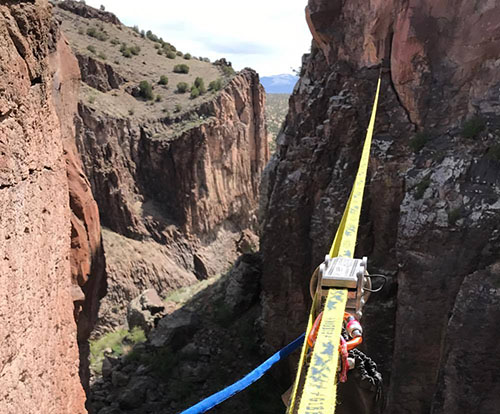lineGrip approved webbing
lineGrip approved webbing

Generally every flat and tubular webbing type made of plain, uncoated polyester (PES) or polyamid (PA/PAD, Nylon), with 24-26 mm width, and a thickness of 1-5 mm, is approved for unrestricted use with the lineGrip.
For these kinds of webbing, you may rely upon the temp-load diagrams found here:
Temperature and Load Diagram >
Tensioning of threaded tubular, stacked flat webbing, and webbing made of high tech fibers (Dyneema, Aramid, etc.) with the lineGrip is possible to a limited extent only, and is therefore excluded specifically. Any use of these (not yet) approved webbing types voids the manufacturers liability. Therefore we advise not to use these for now – if you do, it’s on your own risk and responsibility!
It is explicitly prohibited to use any webbing wider than 26mm with the 1″ lineGrip! Doing so may lead to sudden and unexpected failure of the lineGrip due to possible excessive outwards pressure on the levers, as a result of the webbing trying to unfold to its full width. This might disrupt/destroy the lineGrip and hereby damage other equipment, as well as severely injure any person near the lineGrip!
Special caution is to be observed when using the following types of webbing:
Coated webbing
Since theres many different slackline coating types on the market, all of which we not yet had the chance to test, we have to generally disapprove any coated webbing from use with the lineGrip.
BC Mantra MKII + Spidersilk with “old” (pre 2015) Resin-Coating
May behave critical when wet!
Slipping may occur sooner than with uncoated webbing. Increased caution is advised in combination with these webbings!
Other, more recent BC webbing made of PES or PA with the LineSkin (TM) coating, is fully tested and approved, without any restrictions.
Please note the Feather and Aero restrictions (Hybrid-Blend): no slipping up to 15kN below 25°C, slipping starts at ca. 12kN at 30° C
Webbing with Rubber-Printing (e.g. Gibbon Flowline)
Tip: place the lineGrip at positions with as little as possible rubber application on the webbing!
Slippage of the lineGrip is unfortunately favored by the rubber applications. At what load slipping occurs is dependent upon different factors. Fact is, that it occurs a bit earlier than with plain, uncoated polyester webbings, and may happen suddenly and unexpectedly. Increased caution and attention is therefore advised in combination with this type of webbing!
Webbing made partially (hybrid) or fully of materials other than Polyester (PES) and Polyamid/Nylon (PA).
Slippage may occur prematurely, because it can not be assured that the rubber coatings can generate adequate sticking friction on high-tech materials. Some examples:
• Dyneema-Webbing (Spectra) slips at ca. 7kN, even in the optimum temperature range
• Kevlar-Webbing (Aramid) is most critical, and slippage is to be expected even sooner than with Dyneema
• Vectran-Webbing with Resin-Coating (e.g. Spidersilk II): no slipping up to 15kN below 25°C, slipping starts at ca. 12kN at 30° C
We encourage to NOT use any high-tech webbing with the lineGrip as long as we did not approve it yet (certification/approval is in progress).
If you use “non PES or non PA/PAD” webbing (on your own risk), a reliable backup with minimal slack is ever more important!
This will reduce the risk of injuries and damage to equipment, once the lineGrip really does begin to slip.
When tensioning high-tech webbing with the lineGrip, please ensure to never exceed 5 kN in any case!
This page can be reached directly via quick-link:
linegrip.com/webbing
